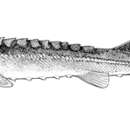Diagnostic Description
provided by FAO species catalogs
Spiracle present. Snout and caudal peduncle subconical. Gill membranes joined to isthmus. Mouth transverse and lower lip with a split in the middle. The barbels are either smooth or slightly fimbriate. The length of the snout is highly variable (33.3-61 % head length). 20-49 gill rakers fan-like, each terminated by several tubercles. D:30-56. A:17-33 fin rays. 10-12 dorsal scutes; 32-62 lateral scutes; 7-16 (20) ventral scutes. The scutes of young specimens are sharply tipped, but no in adult ones. Numerous small bony plates are scattered between the rows of scutes. There is a great variability in the colouration: from light grey to a dark brown on back and sides, and from white to yellowish on the underside.
- Berg, L.S. - 1962. Freshwater fishes of the U.S.S.R. and adjacent countries.Volume 1.Israel Program for Scientific Translations Ltd, Jerusalem. 4th edition. (Russian version published 1948).
- Birstein, V.J. - 1993. Sturgeons and paddlefishes: threatened fishes in need of conservation. 7:773-787.Conserv. Biol.
- Ruban, G.I. - 1997. Species structure, contemporary distribution and status of the Siberian sturgeon, Acipenser baerii. Environ. Biol. Fish. 48: 221-230.
- Sokolov, L.I. & V.P. Vasilev. - 1989. Acipenser baeri Brandt, 1869. In J. Holcíck (ed.) The freshwater fishes of Europe, Vol. I, Part. II: General introduction to fishes, Acipenseriformes. 262-284. Aula-Verlag.
- Williot, P. & T. Roualt. - 1982. Compte rendu d'une première reproduction en France de l'esturgeon sibérien Acipenser baeri. Bull. Fr. Piscicult. 54(286): 255-261.
- bibliographic citation
- Sokolov, L.I. & V.P. Vasilev. - 1989. Acipenser baeri Brandt, 1869. In J. Holcíck (ed.) The freshwater fishes of Europe, Vol. I, Part. II: General introduction to fishes, Acipenseriformes. . 262-284. Aula-Verlag.
- author
- Food and Agriculture Organization of the UN
Distribution
provided by FAO species catalogs
Main Siberian rivers from the Ob to Kolyma, in Lake Baikal, and rarely in the Pechora (Reshetnikov et al., 1997).
- bibliographic citation
- Sokolov, L.I. & V.P. Vasilev. - 1989. Acipenser baeri Brandt, 1869. In J. Holcíck (ed.) The freshwater fishes of Europe, Vol. I, Part. II: General introduction to fishes, Acipenseriformes. . 262-284. Aula-Verlag.
- author
- Food and Agriculture Organization of the UN
Size
provided by FAO species catalogs
The maximum size is 2 m in total length and 210 kg, but usually the do not exceed 65 kg. In the Lena and Kolyma Rivers, they are significantly smaller, normally not exceed 16 kg (Sokolov & Vasilev, 1989).
- bibliographic citation
- Sokolov, L.I. & V.P. Vasilev. - 1989. Acipenser baeri Brandt, 1869. In J. Holcíck (ed.) The freshwater fishes of Europe, Vol. I, Part. II: General introduction to fishes, Acipenseriformes. . 262-284. Aula-Verlag.
- author
- Food and Agriculture Organization of the UN
Brief Summary
provided by FAO species catalogs
During the day, they remain in places where the rive bed is deep and sometimes, congregate at the bottom of lakes. In Lake Baikal these fishes remain at a depth of 20-50 m, but they may descent at 100-150 m.The Siberian sturgeon is a semianadromous or freshwater species, most numerous in the middle and downstream sections of the rivers. They enter brackish water and travel into the bays of the Arctic Ocean.There are two forms of this species in the Siberian River basins: one semi-migratory that remains in estuaries or river deltas for feeding, and the other form, more or less resident in one locality and considerably less numerous than the migrating one.In Siberian waters it feeds mainly on benthic organisms, predominantly chironomid larvae, amphipods, isopods and polychaetes; large quantities of detritus and sediment that sometimes constitute more than 90 % of the stomach contents, are also ingested. This species does not cease feeding during the spawning migration or during the period of actual spawning. It feeds also beneath the ice during the wintering. Males first mature at an age no earlier than 17 or 18 years. First maturity in females is reached not earlier than at an age of 19-20 years. In the Lena River, males first attaining sexual maturity at 9-10 years old and females at an age of 11-12 years. The females do not spawn again until after a period of at least three to five years, while the males can ripen again after two to three years. The migratory form undertake a upstream migration to spawn. The migration is interrupted by hibernation in depressions in the river bed. Males reach the spawning grounds earlier than the females. The spawning period ranges from the end of May to mid-June at a water temperature from 9 to 18º C. Spawn occurs in the main channel of rivers over stony-gravel or gravelly-sand bottoms. The spawning of the resident form of this species are not far from the depressions in which they wintering.
- bibliographic citation
- Sokolov, L.I. & V.P. Vasilev. - 1989. Acipenser baeri Brandt, 1869. In J. Holcíck (ed.) The freshwater fishes of Europe, Vol. I, Part. II: General introduction to fishes, Acipenseriformes. . 262-284. Aula-Verlag.
- author
- Food and Agriculture Organization of the UN
Benefits
provided by FAO species catalogs
Highly commercial. It is one of the most valuable fishes in Siberia. Main catch always came from the Ob River system. At the present time, the populations are subject to overfishing in Lake Baikal and Yenisei River. This species appears to be a valuable candidate for introduction into new regions and for aquaculture (Sokolov & Vasilev, 1989).
- bibliographic citation
- Sokolov, L.I. & V.P. Vasilev. - 1989. Acipenser baeri Brandt, 1869. In J. Holcíck (ed.) The freshwater fishes of Europe, Vol. I, Part. II: General introduction to fishes, Acipenseriformes. . 262-284. Aula-Verlag.
- author
- Food and Agriculture Organization of the UN

